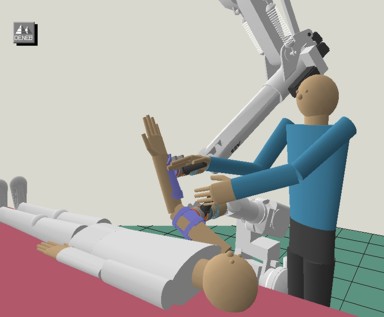While researchers may seek improved machinery to ease tasks of daily life,
“it is quite obvious and very clear to all of those working in the field of aids for disabled that, although disabled persons may accept ‘artificial’ devices as assistants, their dream and ultimate goal is to be able to manipulate and walk again."
When a person suffers a stroke or spinal cord injury, what are the options for regaining independence? Not long ago, only three major pieces of equipment were offered to augment mobility: a cane, a walker, and a wheelchair, depending on the severity of loss of abilities of the affected individual. Today, all three of these assistive options are available in robotic form [11]. More so, with 30,000 products currently available [12], the art of assistive technology is moving towards the

establishment of a science of assistive technology [13]. However, scientists and the medical community are not merely looking to match an individual with an aid to increase autonomy–some are seeking ways to use assistive technology towards actual rehabilitation. Integrating robotics into assistive technology leads to what many predict will be our next revolution [9]. As we evaluate assistive technology in the year 2003, it becomes apparent that scientists are practicing interdisciplinary approaches–to understand how a robotic apparatus should work, robotic engineers look at the system it is meant to mimic. In addition, one seemingly unrelated discovery can prove useful to scientists looking for ways to incorporate a body of knowledge into useful, other purposes. By this means, it is possible that developments in any field of robotics or any bodies of knowledge may reveal themselves in the future to serve purposeful applications for rehabilitative robotics. The focus of this study is not to examine the newest product lines available to assist mobility for a stroke or spinal cord injury victim but rather to explore how robotics is being implemented to recover lost abilities for stroke and spinal cord injury victims.
 establishment of a science of assistive technology [13]. However, scientists and the medical community are not merely looking to match an individual with an aid to increase autonomy–some are seeking ways to use assistive technology towards actual rehabilitation. Integrating robotics into assistive technology leads to what many predict will be our next revolution [9]. As we evaluate assistive technology in the year 2003, it becomes apparent that scientists are practicing interdisciplinary approaches–to understand how a robotic apparatus should work, robotic engineers look at the system it is meant to mimic. In addition, one seemingly unrelated discovery can prove useful to scientists looking for ways to incorporate a body of knowledge into useful, other purposes. By this means, it is possible that developments in any field of robotics or any bodies of knowledge may reveal themselves in the future to serve purposeful applications for rehabilitative robotics. The focus of this study is not to examine the newest product lines available to assist mobility for a stroke or spinal cord injury victim but rather to explore how robotics is being implemented to recover lost abilities for stroke and spinal cord injury victims.
establishment of a science of assistive technology [13]. However, scientists and the medical community are not merely looking to match an individual with an aid to increase autonomy–some are seeking ways to use assistive technology towards actual rehabilitation. Integrating robotics into assistive technology leads to what many predict will be our next revolution [9]. As we evaluate assistive technology in the year 2003, it becomes apparent that scientists are practicing interdisciplinary approaches–to understand how a robotic apparatus should work, robotic engineers look at the system it is meant to mimic. In addition, one seemingly unrelated discovery can prove useful to scientists looking for ways to incorporate a body of knowledge into useful, other purposes. By this means, it is possible that developments in any field of robotics or any bodies of knowledge may reveal themselves in the future to serve purposeful applications for rehabilitative robotics. The focus of this study is not to examine the newest product lines available to assist mobility for a stroke or spinal cord injury victim but rather to explore how robotics is being implemented to recover lost abilities for stroke and spinal cord injury victims.